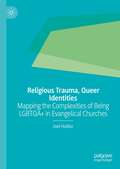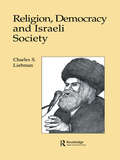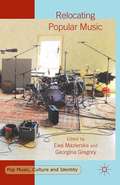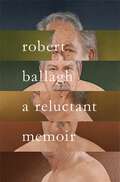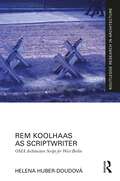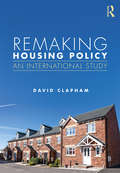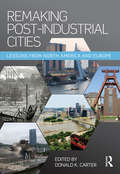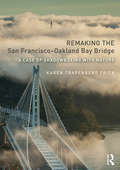- Table View
- List View
Religious Representation in Place: Exploring Meaningful Spaces at the Intersection of the Humanities and Sciences (Religion and Spatial Studies)
by Mark K. George Daria Pezzoli-OlgiatiReligious Representation in Place brings together an interdisciplinary group of scholars from the Humanities and Sciences to broaden the understanding of how religious symbols and spatial studies interact. The essays consider the relevance of religion in the experience of space, a fundamental dimension of culture and human life.
Religious Trauma, Queer Identities: Mapping the Complexities of Being LGBTQA+ in Evangelical Churches
by Joel HollierIn a polarised milieu that too often posits “queer” and “Christian” as competing realms, this book explores the complexities of identity development, religious traumatisation, and the task of creating safe faith spaces in which LGBTQA+ people can find healing, particularly in the Evangelical context. First, Joel Hollier examines the historical path of Evangelicalism, providing context for the current terrain of the “culture war” we find ourselves in. He then parses out experiences of gender/sexuality and religious/spiritual identity development, grounding them in an evolving theoretical base. Finally, Hollier offers a rounded critique of Evangelical church structures and mechanisms of trauma that hinder the healing process, along with potential sources of healing. Central to this work are the voices of LGBTQA+ people whose stories weave together a deeper understanding of the harms the Church has perpetrated, and the path forward.
Relign Democrcy & Israeli Soc
by LiebmanFirst Published in 1997. Routledge is an imprint of Taylor & Francis, an informa company.
Relign Democrcy & Israeli Soc
by LiebmanFirst Published in 1997. Routledge is an imprint of Taylor & Francis, an informa company.
Relocating Popular Music (Pop Music, Culture and Identity)
by Ewa MazierskaRelocating Popular Music uses the lens of colonialism and tourism to analyse types of music movements, such as transporting music from one place or historical period to another, hybridising it with a different style and furnishing it with new meaning. It discusses music in relation to music video, film, graphic arts, fashion and architecture.
Relocating Television: Television in the Digital Context (Comedia)
by Jostein GripsrudFor over half a century, television has been the most central medium in Western democracies – the political, social and cultural centrepiece of the public sphere. Television has therefore rarely been studied in isolation from its socio-cultural and political context; there is always something important at stake when the forms and functions of television are on the agenda. The digitisation of television concerns the production, contents, distribution and reception of the medium, but also its position in the overall, largely digitised media system and public sphere where the internet plays a decisive role. The articles in this comprehensive collection are written by some of the world’s most prominent scholars in the field of media, communication and cultural studies, including critical film and television studies. Relocating Television offers readers an insight into studying television alongside the internet, participatory media and other technocultural phenomena such as DVDs, user-generated content and everyday digital media production. It also focuses on more specific programmes and phenomena, including The Wire, MSN, amateur footage in TV news, Bollywoodization of TV news, YouTube, fan sites tied to e.g. Grey's Anatomy and X Factor. Relocating Television will be highly beneficial to both students and academics across a wide range of undergraduate and postgraduate courses including media, communication and cultural studies, and television and film studies.
Relocating Television: Television in the Digital Context (Comedia)
by Jostein GripsrudFor over half a century, television has been the most central medium in Western democracies – the political, social and cultural centrepiece of the public sphere. Television has therefore rarely been studied in isolation from its socio-cultural and political context; there is always something important at stake when the forms and functions of television are on the agenda. The digitisation of television concerns the production, contents, distribution and reception of the medium, but also its position in the overall, largely digitised media system and public sphere where the internet plays a decisive role. The articles in this comprehensive collection are written by some of the world’s most prominent scholars in the field of media, communication and cultural studies, including critical film and television studies. Relocating Television offers readers an insight into studying television alongside the internet, participatory media and other technocultural phenomena such as DVDs, user-generated content and everyday digital media production. It also focuses on more specific programmes and phenomena, including The Wire, MSN, amateur footage in TV news, Bollywoodization of TV news, YouTube, fan sites tied to e.g. Grey's Anatomy and X Factor. Relocating Television will be highly beneficial to both students and academics across a wide range of undergraduate and postgraduate courses including media, communication and cultural studies, and television and film studies.
Reluctant Celebrity: Affect and Privilege in Contemporary Stardom (PDF)
by Lorraine YorkIn this book, Lorraine York examines the figure of the celebrity who expresses discomfort with his or her intense condition of social visibility. Bringing together the fields of celebrity studies and what Ann Cvetkovich has called the “affective turn in cultural studies”, York studies the mixed affect of reluctance, as it is performed by public figures in the entertainment industries. Setting aside the question of whether these performances are offered “in good faith” or not, York theorizes reluctance as the affective meeting ground of seemingly opposite emotions: disinclination and inclination. The figures under study in this book are John Cusack, Robert De Niro, and Daniel Craig—three white, straight, cis-gendered-male cinematic stars who have persistently and publicly expressed a feeling of reluctance about their celebrity. York examines how the performance of reluctance, which is generally admired in celebrities, builds up cultural prestige that can then be turned to other purposes.
A Reluctant Memoir
by Robert BallaghA fiercely honest and unvarnished autobiography from Ireland's most successful and controversial living artist. Making his name as a Pop artist in the late 1960s and 70s, Robert Ballagh quickly achieved an international reputation. With little formal artistic training, he triumphed in his field despite often formidable hostility. His work was also strikingly topical and political, playing with classic images by Goya or Delacroix to express outrage about the situation in Northern Ireland. But it is his series of realistic portraits of writers, politicians and fellow artists – often searingly inquisitive and moving in equal measure – that have won him lasting fame. His subjects include Brian Friel, Seamus Heaney, Samuel Beckett, James Watson, Francis Crick, Harold Pinter and Fidel Castro. And his remarkable self-portraits unsparingly document the process of his own ageing. This memoir is also a story of Ireland over the past sixty years, its violence, hypocrisy and immobility as well as its creativity and generosity.
Rem Koolhaas as Scriptwriter: OMA Architecture Script for West Berlin (Routledge Research in Architecture)
by Helena Huber-DoudováThis book is the first survey of a new field in architecture theory: script writing. Rem Koolhaas as Scriptwriter explores the intersection of architecture, film, and text using the example of the working method of scriptwriter, Rem Koolhaas, and the Office for Metropolitan Architecture (OMA). This book argues that Koolhaas formulates his approach to architecture on the basis of the “written sketch” or script, and questions its transformations into built environment in the oeuvre of OMA. Divided into two parts, the first part is a theoretical outline that explores the notion of scriptwriting in film. It provides in-depth insights into the definition and historical evolution of the script—as a blueprint, Hollywood script, avant-garde script, storyboard, the relation to auteur theory, and the difference between the script and scenario. It surveys the first original script for the Exodus, of the Voluntary Prisoners of Architecture. The second part offers a unique perspective on the urban development of West Berlin, in which Koolhaas created a metropolitan script, or blueprint, that spans the period 1971–1989, from his first visit to Berlin to the fall of the Berlin Wall. This book will be of interest to researchers and students of architectural theory, urban history, and film studies.
Rem Koolhaas as Scriptwriter: OMA Architecture Script for West Berlin (Routledge Research in Architecture)
by Helena Huber-DoudováThis book is the first survey of a new field in architecture theory: script writing. Rem Koolhaas as Scriptwriter explores the intersection of architecture, film, and text using the example of the working method of scriptwriter, Rem Koolhaas, and the Office for Metropolitan Architecture (OMA). This book argues that Koolhaas formulates his approach to architecture on the basis of the “written sketch” or script, and questions its transformations into built environment in the oeuvre of OMA. Divided into two parts, the first part is a theoretical outline that explores the notion of scriptwriting in film. It provides in-depth insights into the definition and historical evolution of the script—as a blueprint, Hollywood script, avant-garde script, storyboard, the relation to auteur theory, and the difference between the script and scenario. It surveys the first original script for the Exodus, of the Voluntary Prisoners of Architecture. The second part offers a unique perspective on the urban development of West Berlin, in which Koolhaas created a metropolitan script, or blueprint, that spans the period 1971–1989, from his first visit to Berlin to the fall of the Berlin Wall. This book will be of interest to researchers and students of architectural theory, urban history, and film studies.
Remaking Birmingham: The Visual Culture of Urban Regeneration
by Liam KennedyThe city of Birmingham offers a particularly rich case study on urban regeneration as it strives to build a new city image. Positioned between decline and regeneration, the landscape of the city and its environs collages old and new, producing dramatic contrasts - of industrial and post-industrial urbanisms of crumbling brutalism and spectacular flagship developments, of Victorian housing and diverse cultural lifestyles - that compound the aesthetic and socio-economic means of regeneration. This visually exciting book also reflects upon and extends current debates about public space, cultural zoning and the futures of cities.
Remaking Birmingham: The Visual Culture of Urban Regeneration
by Liam KennedyThe city of Birmingham offers a particularly rich case study on urban regeneration as it strives to build a new city image. Positioned between decline and regeneration, the landscape of the city and its environs collages old and new, producing dramatic contrasts - of industrial and post-industrial urbanisms of crumbling brutalism and spectacular flagship developments, of Victorian housing and diverse cultural lifestyles - that compound the aesthetic and socio-economic means of regeneration. This visually exciting book also reflects upon and extends current debates about public space, cultural zoning and the futures of cities.
Remaking Cities: An Introduction to Urban Metrofitting
by Tony FryUnprecedented challenges await the future of the world's cities. Accelerating population pressure, climate change, food insecurity, poverty and geopolitical instability – in the face of such problems our current attempts at producing a sustainable agenda for the world's cities appear fragmented and inadequate. Fresh thinking is needed.In Remaking Cities, renowned design theorist Tony Fry brings a conceptual design perspective to the challenge of urban sustainability and resilience. In a typically far-sighted and provocative work, Fry presents ideas and actions for 'metrofitting' – a new kind of practice in architecture and urban design. Metrofitting expands the technological concept of retrofit up to the city scale, placing social, cultural, political and ethical concerns at its heart. Metrofitting is not about visionary technology, it is about transforming existing cities by combining available resources with human creativity, prompted by new thinking about new and old urban problems. It requires overcoming outmoded Eurocentric assumptions of what constitutes a city, rethinking their forms and structures, and understanding their metabolic processes and social and economic functions. This book provides conceptually strong practical approaches that will ultimately change the whole way we view cities and the way the urban future is designed. Illustrated with international case studies of metrofitting in action, Remaking Cities will provoke and stimulate debate among architects, urban designers, and anyone concerned with the urban environment and social and cultural change.
Remaking Cities: An Introduction to Urban Metrofitting
by Tony FryUnprecedented challenges await the future of the world's cities. Accelerating population pressure, climate change, food insecurity, poverty and geopolitical instability – in the face of such problems our current attempts at producing a sustainable agenda for the world's cities appear fragmented and inadequate. Fresh thinking is needed.In Remaking Cities, renowned design theorist Tony Fry brings a conceptual design perspective to the challenge of urban sustainability and resilience. In a typically far-sighted and provocative work, Fry presents ideas and actions for 'metrofitting' – a new kind of practice in architecture and urban design. Metrofitting expands the technological concept of retrofit up to the city scale, placing social, cultural, political and ethical concerns at its heart. Metrofitting is not about visionary technology, it is about transforming existing cities by combining available resources with human creativity, prompted by new thinking about new and old urban problems. It requires overcoming outmoded Eurocentric assumptions of what constitutes a city, rethinking their forms and structures, and understanding their metabolic processes and social and economic functions. This book provides conceptually strong practical approaches that will ultimately change the whole way we view cities and the way the urban future is designed. Illustrated with international case studies of metrofitting in action, Remaking Cities will provoke and stimulate debate among architects, urban designers, and anyone concerned with the urban environment and social and cultural change.
Remaking Housing Policy: An International Study
by David ClaphamBreaking the country-specific boundaries of traditional housing policy books, Remaking Housing Policy is the first introductory housing policy textbook designed to be used by students all around the world. Starting from first principles, readers are guided through the objectives behind government housing policy interventions, the tools and mechanisms deployed and the outcomes of the policy decisions. A range of international case studies from Europe, Asia, Africa and the Americas illustrate the book’s general principles and demonstrate how different regimes influence policy. The rise of the neo-classical discourse of market primacy in housing has left many countries with an inappropriate mix of state and market processes with major interventions that do not achieve what they were intended to do. Remaking Housing Policy goes back to basics to show what works and what doesn’t and how policy can be improved for the future. Remaking Housing Policy provides readers with a comprehensive introduction to the objectives and mechanisms of social housing. This innovative international textbook will be suitable for academics, housing students and those on related courses across geography, planning, property and urban studies.
Remaking Housing Policy: An International Study
by David ClaphamBreaking the country-specific boundaries of traditional housing policy books, Remaking Housing Policy is the first introductory housing policy textbook designed to be used by students all around the world. Starting from first principles, readers are guided through the objectives behind government housing policy interventions, the tools and mechanisms deployed and the outcomes of the policy decisions. A range of international case studies from Europe, Asia, Africa and the Americas illustrate the book’s general principles and demonstrate how different regimes influence policy. The rise of the neo-classical discourse of market primacy in housing has left many countries with an inappropriate mix of state and market processes with major interventions that do not achieve what they were intended to do. Remaking Housing Policy goes back to basics to show what works and what doesn’t and how policy can be improved for the future. Remaking Housing Policy provides readers with a comprehensive introduction to the objectives and mechanisms of social housing. This innovative international textbook will be suitable for academics, housing students and those on related courses across geography, planning, property and urban studies.
Remaking Kurosawa: Translations and Permutations in Global Cinema
by Dolores MartinezThrough the lens of Akira Kurosawa's films, Martinez dissects the human tendency to make connections in a pioneering attempt to build a bridge out of diverse materials: the anthropology of Japan, film studies, and postmodern theory.
Remaking London: Decline and Regeneration in Urban Culture (International Library Of Human Geography Ser.)
by Ben CampkinContemporary urban regeneration seeks to encourage diverse, creative new neighbourhoods that are rich in economic potential. Yet the end result frequently displaces precisely those qualities, activities and communities it claims to engender. Are people best served by a preoccupation with regeneration as economic growth? In The Regeneration Game Ben Campkin provides a lucid and wide-ranging critique of contemporary regeneration. Focusing on present-day regeneration areas in London that are key to the capital's modern identity, including the site of the 2012 Olympics, the result is both a compelling account of contested sites within the capital's recent history and a powerful critique of modern methods of urban regeneration.
Remaking Post-Industrial Cities: Lessons from North America and Europe
by Donald K. CarterRemaking Post-Industrial Cities: Lessons from North America and Europe examines the transformation of post-industrial cities after the precipitous collapse of big industry in the 1980s on both sides of the Atlantic, presenting a holistic approach to restoring post-industrial cities. Developed from the influential 2013 Remaking Cities Congress, conference chair Donald K. Carter brings together ten in-depth case studies of cities across North America and Europe, documenting their recovery from 1985 to 2015. Each chapter discusses the history of the city, its transformation, and prospects for the future. The cases cross-cut these themes with issues crucial to the resilience of post-industrial cities including sustainability; doing more with less; public engagement; and equity (social, economic and environmental), the most important issue cities face today and for the foreseeable future. This book provides essential "lessons learned" from the mistakes and successes of these cities, and is an invaluable resource for practitioners and students of planning, urban design, urban redevelopment, economic development and public and social policy.
Remaking Post-Industrial Cities: Lessons from North America and Europe
by Donald K. CarterRemaking Post-Industrial Cities: Lessons from North America and Europe examines the transformation of post-industrial cities after the precipitous collapse of big industry in the 1980s on both sides of the Atlantic, presenting a holistic approach to restoring post-industrial cities. Developed from the influential 2013 Remaking Cities Congress, conference chair Donald K. Carter brings together ten in-depth case studies of cities across North America and Europe, documenting their recovery from 1985 to 2015. Each chapter discusses the history of the city, its transformation, and prospects for the future. The cases cross-cut these themes with issues crucial to the resilience of post-industrial cities including sustainability; doing more with less; public engagement; and equity (social, economic and environmental), the most important issue cities face today and for the foreseeable future. This book provides essential "lessons learned" from the mistakes and successes of these cities, and is an invaluable resource for practitioners and students of planning, urban design, urban redevelopment, economic development and public and social policy.
Remaking Reality: U.S. Documentary Culture after 1945
by Sara Blair, Joseph B. Entin, and Franny NudelmanAfter World War II, U.S. documentarians engaged in a rigorous rethinking of established documentary practices and histories. Responding to the tumultuous transformations of the postwar era--the atomic age, the civil rights movement, the Vietnam War, the emergence of the environmental movement, immigration and refugee crises, student activism, the globalization of labor, and the financial collapse of 2008--documentary makers increasingly reconceived reality as the site of social conflict and saw their work as instrumental to struggles for justice. Examining a wide range of forms and media, including sound recording, narrative journalism, drawing, photography, film, and video, this book is a daring interdisciplinary study of documentary culture and practice from 1945 to the present. Essays by leading scholars across disciplines collectively explore the activist impulse of documentarians who not only record reality but also challenge their audiences to take part in reality's remaking.In addition to the editors, the volume's contributors include Michael Mark Cohen, Grace Elizabeth Hale, Matthew Frye Jacobson, Jonathan Kahana, Leigh Raiford, Rebecca M. Schreiber, Noah Tsika, Laura Wexler, and Daniel Worden.
Remaking the Readymade: Duchamp, Man Ray, and the Conundrum of the Replica (Studies in Surrealism)
by Adina Kamien-KazhdanReplication and originality are central concepts in the artistic oeuvres of Marcel Duchamp and Man Ray. Remaking the Readymade reveals the underlying and previously unexplored processes and rationales for the collaboration between Duchamp, Man Ray, and Arturo Schwarz on the replication of readymades and objects. The 1964 editioned replicas of the readymades sent shock waves through the art world. Even though the replicas undermined ideas of authorship and problematized the notion of identity and the artist, they paradoxically shared in the aura of the originals, becoming stand-ins for the readymades. Scholar-poet-dealer Arturo Schwarz played a crucial role, opening the door to joint or alternate authorship—an outstanding relationship between artist and dealer. By unearthing previously unpublished correspondence and documentary materials and combining this material with newly conducted exclusive interviews with key participants, Remaking the Readymade details heretofore unrevealed aspects of the technical processes involved in the (re)creation of iconic, long-lost Dada objects. Launched on the heels of the centenary of Duchamp’s Fountain, this new analysis intensifies and complicates our understanding of Duchamp and Man Ray’ initial conceptions, and raises questions about replication and authorship that will stimulate significant debate about the legacy of the artists, the continuing significance of their works, and the meaning of terms such as creativity, originality, and value in the formation of art.
Remaking the Readymade: Duchamp, Man Ray, and the Conundrum of the Replica (Studies in Surrealism)
by Adina Kamien-KazhdanReplication and originality are central concepts in the artistic oeuvres of Marcel Duchamp and Man Ray. Remaking the Readymade reveals the underlying and previously unexplored processes and rationales for the collaboration between Duchamp, Man Ray, and Arturo Schwarz on the replication of readymades and objects. The 1964 editioned replicas of the readymades sent shock waves through the art world. Even though the replicas undermined ideas of authorship and problematized the notion of identity and the artist, they paradoxically shared in the aura of the originals, becoming stand-ins for the readymades. Scholar-poet-dealer Arturo Schwarz played a crucial role, opening the door to joint or alternate authorship—an outstanding relationship between artist and dealer. By unearthing previously unpublished correspondence and documentary materials and combining this material with newly conducted exclusive interviews with key participants, Remaking the Readymade details heretofore unrevealed aspects of the technical processes involved in the (re)creation of iconic, long-lost Dada objects. Launched on the heels of the centenary of Duchamp’s Fountain, this new analysis intensifies and complicates our understanding of Duchamp and Man Ray’ initial conceptions, and raises questions about replication and authorship that will stimulate significant debate about the legacy of the artists, the continuing significance of their works, and the meaning of terms such as creativity, originality, and value in the formation of art.
Remaking the San Francisco-Oakland Bay Bridge: A Case of Shadowboxing with Nature (Planning, History and Environment Series)
by Karen Trapenberg FrickWinner of TransportiCA’s September Book Club Award 2018 On 17 October 1989 one the largest earthquakes to occur in California since the San Francisco earthquake of April 1906 struck Northern California. Damage was extensive, none more so than the partial collapse of the San Francisco–Oakland Bay Bridge’s eastern span, a vital link used by hundreds of thousands of Californians every day. The bridge was closed for a month for repairs and then reopened to traffic. But what ensued over the next 25 years is the extraordinary story that Karen Trapenberg Frick tells here. It is a cautionary tale to which any governing authority embarking on a megaproject should pay heed. She describes the process by which the bridge was eventually replaced as an exercise in shadowboxing which pitted the combined talents and shortcomings, partnerships and jealousies, ingenuity and obtuseness, generosity and parsimony of the State’s and the region’s leading elected officials, engineers, architects and other members of the governing elites against a collectively imagined future catastrophe of unknown proportions. In so doing she highlights three key questions: If safety was the reason to replace the bridge, why did it take almost 25 years to do so? How did an original estimate of $250 million in 1995 soar to $6.5 billion by 2014? And why was such a complex design chosen? Her final chapter – part epilogue, part reflection – provides recommendations to improve megaproject delivery and design.

